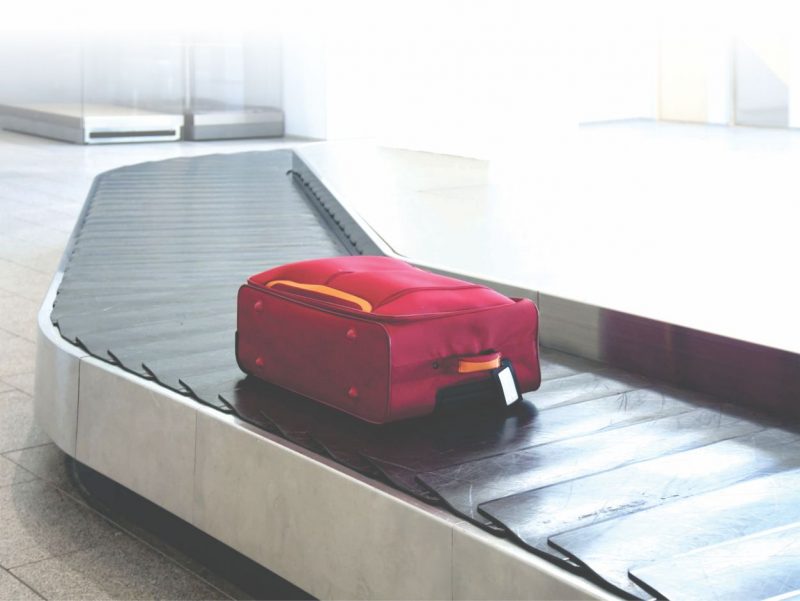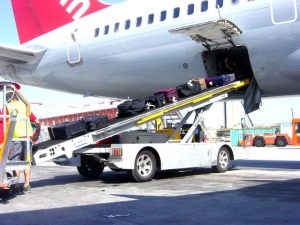How is your baggage handled at the airport?
The baggage handling system market is estimated to be valued at US$6.45 billion in 2015, and is projected to reach US$9.36 billion by 2020, at a CAGR of 7.72% during the forecast period from 2015-2020, according to markets and markets projection.
The hot summer months in the Middle East are also the busiest months for us to travel across the globe. Proper handling of our baggage makes our travels happy, satisfactory and at ease.
A baggage handling system is an integral part of any commercial flight airport and the operational efficiency of an airport is largely dependent on this system.
A smartly designed baggage handling system helps in improving passenger convenience while reducing aircraft turnaround time. The system includes conveyors, identification devices, screening devices, sortation devices and destination-coded vehicles.
The baggage handling system market is estimated to be valued at US$6.45 billion in 2015, and is projected to reach US$9.36 billion by 2020, at a CAGR of 7.72% during the forecast period from 2015-2020, according to markets and markets projection.
We discussed with baggage handling experts John Mitchell – Senior Manager Baggage and Cargo logistics, dnata and with Klaus Schäfer, Managing Director, BEUMER Group A/S how a baggage handling system works.
Basic aspects
Reliability, speed and efficiency are paramount for a modern baggage handling system. As an integral part of the passenger experience, a seamless, end-to-end process is crucial for ensuring that passengers continue to enjoy using the airport and report the highest satisfaction ratings.
There are different types of baggage handling system (BHS), one example is DXB: this is a tote system: A bag is injected to the BHS from either check-in or a transfer laterals, the identified by an automatic tag reader (ATR) which reads baggage tag bar code representing the standard IATA 10 digit code.
This code is compared to the BHS database and assigned to a tote. Tote is then assigned to an output destination (carousel) if a near time departure or and early bag store (EBS) if far time. When it is time to load the bag is tipped out of the tote and fed to the carousel, according to dnata.
Beumer Group’s tote-based baggage handling system the CrisBag® system’s Crisplant technology platform, fulfills all of these core criteria and adds 100% tracking and traceability throughout the entire baggage handling process.
Klaus Schäfer notes, “With the CrisBag® system, each bag is placed in an individual tote after check-in and the bag tag’s IATA barcode is linked to the tote’s embedded RF tag. The bag and tote are never separated and RF readers integrated into the track at critical points continually monitor and verify the position of the bag within the system”.
Beumer Group’s another aspect of a typical baggage handling system is the Early Baggage Storage (EBS).
The EBS technology can allow baggage to be checked-in hours before the flight time, Gatwick, for example, offers check-in 18 hours before departure. This not only provides more flexibility for passengers, but also benefits the airport by helping to manage peak volumes and reduce labour requirements.
As a next-generation, dynamic EBS, BEUMER Group’s CrisStore® system can enable more flexible staffing patterns at the loading gate and streamline the loading process through batch building of baggage.
Based on a modular rack-based storage system, CrisStore® is integrated into the main BHS to maintain 100% traceability and can be implemented in minimal footprint whist providing for easy future expansion.
Tracking process
Currently, baggage handling can be a very fragmented process: check-in is handled by the airline; make-up by a ground-handler; arrivals by a different ground-handler; and reclaim carousels by the airport or airline. With the implementation of IATA 753 Resolution in 2018, IATA airlines will bear the ultimate responsibility for ensuring that each bag is delivered to the destination and passenger on arrival.
“Security is one area, which has previously presented issues of both traceability and delays as bags are removed from the sorting system for more intense scrutiny. As a tote-based baggage-handling system Crisbag® helps to overcome these issues by ensuring that each bag stays within its individual tote during the screening process.
“This enables each bag to be fully tracked and traceable throughout the screening process and allows the airport to benefit from high load-sharing of Hold Baggage Screening machines and fast transport between screening areas. CrisBag® therefore makes it possible for airports to meet the tightest security regulations with the optimum number of screening machines and without creating unnecessary bottle-necks and delays,” notes Schäfer.
John Mitchell of Dnata says, “At DXB we receive Baggage Process Messages (BPM’s) created by various processing systems. These represent the touch points a bag passes – like the ATR in BHS. We also scan containers and bags with PDA’s at points outside the BHS”
Airport operations
Today’s demand for high capacity and high security can only be achieved with individual traceability and control of each item of baggage throughout the Baggage Handling System (BHS).
A fully integrated end-to-end baggage handling system must integrate technology for security screening, storage, sortation and transportation from check-in to loading, as well as for the handling of arrival baggage.
Klaus said, “BEUMER Group’s Airport Software Suite ensures the required visibility and traceability of baggage at any stage in the process. In addition, Residential Service Contracts provide 24/7 system optimisation and effective maintenance programs, which ensure the highest levels of system availability and performance”.
“Comprehensive baggage tracking allows early decision making and to operationally employ pro-active tactics to intervene and connect bags that would otherwise be ‘at risk,” notes Mitchell.
Reducing these connection times will help airports to enhance passenger satisfaction and improve the overall capacity within their systems.
Within a 45-minute transfer time there is typically sufficient flexibility for the passenger to make their connection even if the inbound flight is delayed by 15 minutes, but the chance of their bags being loaded on the flight is significantly reduced.
Unreadable bag tags are one of the key reasons why transfer baggage is delayed. When a tag cannot be read by the automated system, it can take several minutes for it to be diverted to a Manual Encoding Station (MES) before being routed back into the automated system. These few minutes can make the difference between the bag making and missing the flight.
The introduction of a Video Coding System (VCS) helps to minimise this delay by enabling the bag-source information to be viewed and encoded remotely, while the bag remains in motion within the main BHS.
This means that the majority of no-read bags no longer have to be diverted to an MES, which results in fewer missed transfer flights in addition to allowing the airport to shavepeaks and minimise bottlenecks, according to BEUMER group.
According to dnata, baggage specific resource allocation tools are used for servicing transfer baggage from arrival flights to an optimum BHS input point to support minimum in-system time. A dynamic BHS which can direct at risk bags to an output nearest to the departing aircraft.
Productivity and availability
Beumer Group utilizes remote access to information and controls, via tablet computers that provide significant improvements in both maintenance productivity and system availability.
“Tablets allow maintenance technicians to access technical documentation, such as a schematic of a particular section of the system, and receive live requests from the control room whilst they are standing next to the BHS. This also ensures that maintenance technicians and operators have access to the latest data, such as the maintenance records for each section of the BHS or the current screening status of a bag found on the floor of the baggage hall or dropped from a trolley on the apron,” explains Klaus.
dnata utilizes Baggage Reconciliation System for tracking and security; BHS for conveyance; Allocation systems to load and move; Activity Control Systems; Analytics
Recent breakthrough
Dnata’s recent breathrough has been RFID and BLE tags, which are becoming more available and affordable to replace traditional baggage tags – associated equipment to process and BHS batch handling techniques, which optimise material flow and efficiency.
Beumer Group’s recent breakthrough has been the development of the dynamic Early Baggage Store (EBS). Traditionally, the EBS has been used simply as a holding-space for baggage before it is sent to make-up.
EBS, therefore, is useful for allowing passengers to check-in early and spend more time within the airport’s retail section. Major hub airports also use the EBS for storing transfer bags before they are required for loading onto the onward flight.
BEUMER’s MD remarks, “A dynamic EBS, such as BEUMER Group’s CrisStore® from the Crisplant technology platform, essentially enables airports to transform baggage handling from a ‘push’ system into a ‘pull’ system. In a typical ‘push’ system, bags are introduced, sorted and discharged to a certain destination, perhaps with a short stay in a conventional EBS whilst waiting for the loading gate to open. In a dynamic EBS, bags are stored individually in totes in a high-bay racking system with 100% tracking so that bags can be retrieved either individually or in batches at any time.
“This creates a ‘pull’ system in which control of the flow of baggage is transferred from the main control room to the operator in the EBS. By monitoring the bags held in the EBS, the ground-handler can assess when there are sufficient bags to fill a single ULD, or for a specific flight, and then recall individual bags to create a batch ready for speed-loading. This allows the operator the flexibility to plan the loading process more efficiently in addition to helping the airport to increase productivity by opening a position, loading the bags, and then closing the position.”
The first ‘pull’ system based on a CrisStore® dynamic EBS has already been installed at Bergen Airport, Norway.
Future automation process
dnata’sRobots and batching cells are interesting and dedicated conveyance networks from baggage make-up areas to aircraft parking bays using AGV’s are too.
Another aspect is Baggage Reconciliation Systems (BRS) which ensure that baggage is cleared to travel – this involves scanning the barcode on abaggage tag.
The scanning is usually undertaken using a hand held device which makes physicalhandling awkward and clumsy; dnata have developed a POC which uses Google glass to scan, which releases the loaders hands to handle the bags.
To sum it all up, baggage handling can only attain the highest standards if the infrastructure is kept ahead of demand, all associated processes and systems are fully integrated and collaborative with its decision making, absolute certainty can be introduced to the logistics value chain, optimum efficiency in presentation of product and handling, automation of loading / unloading and big data analysis.












